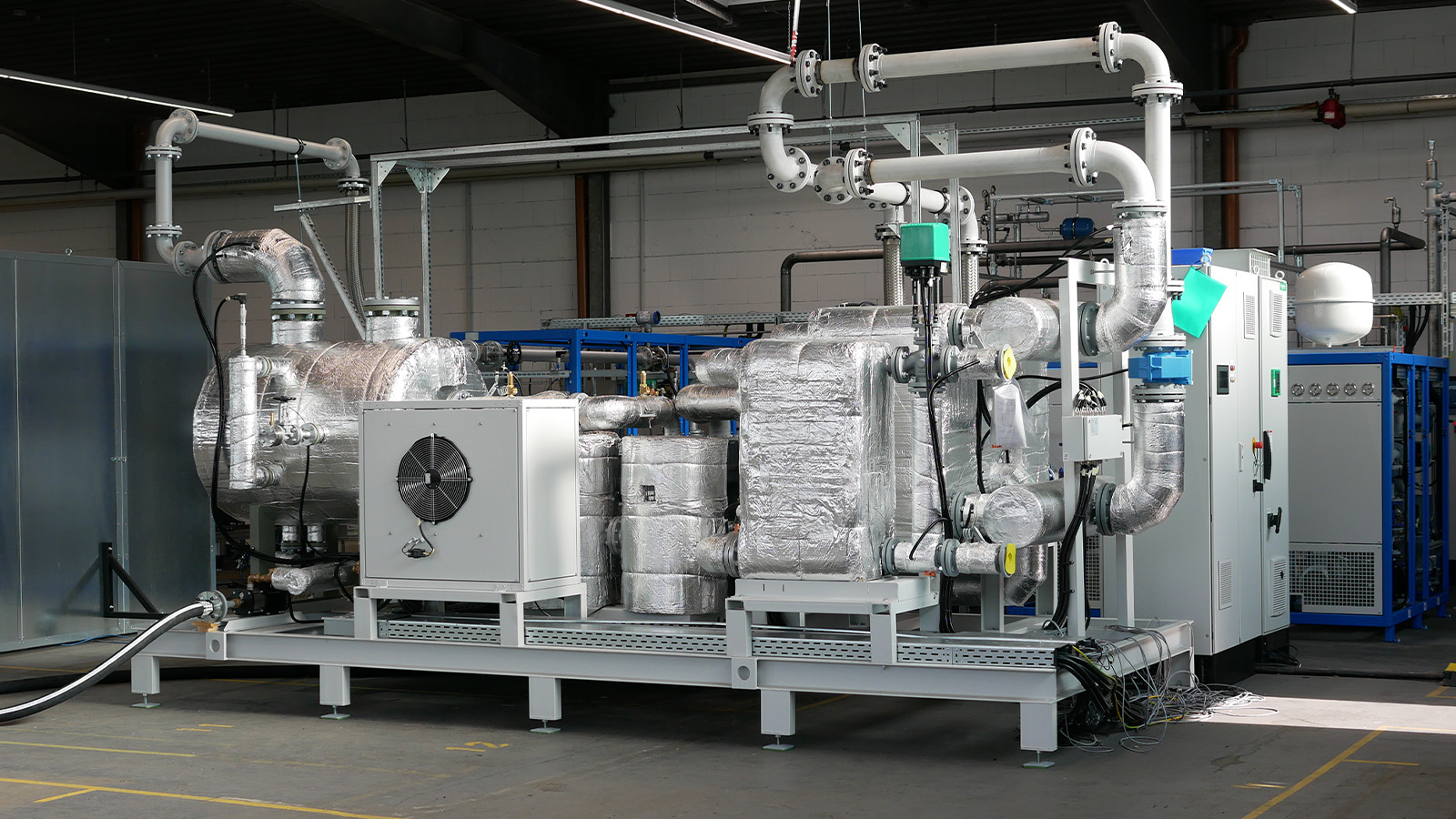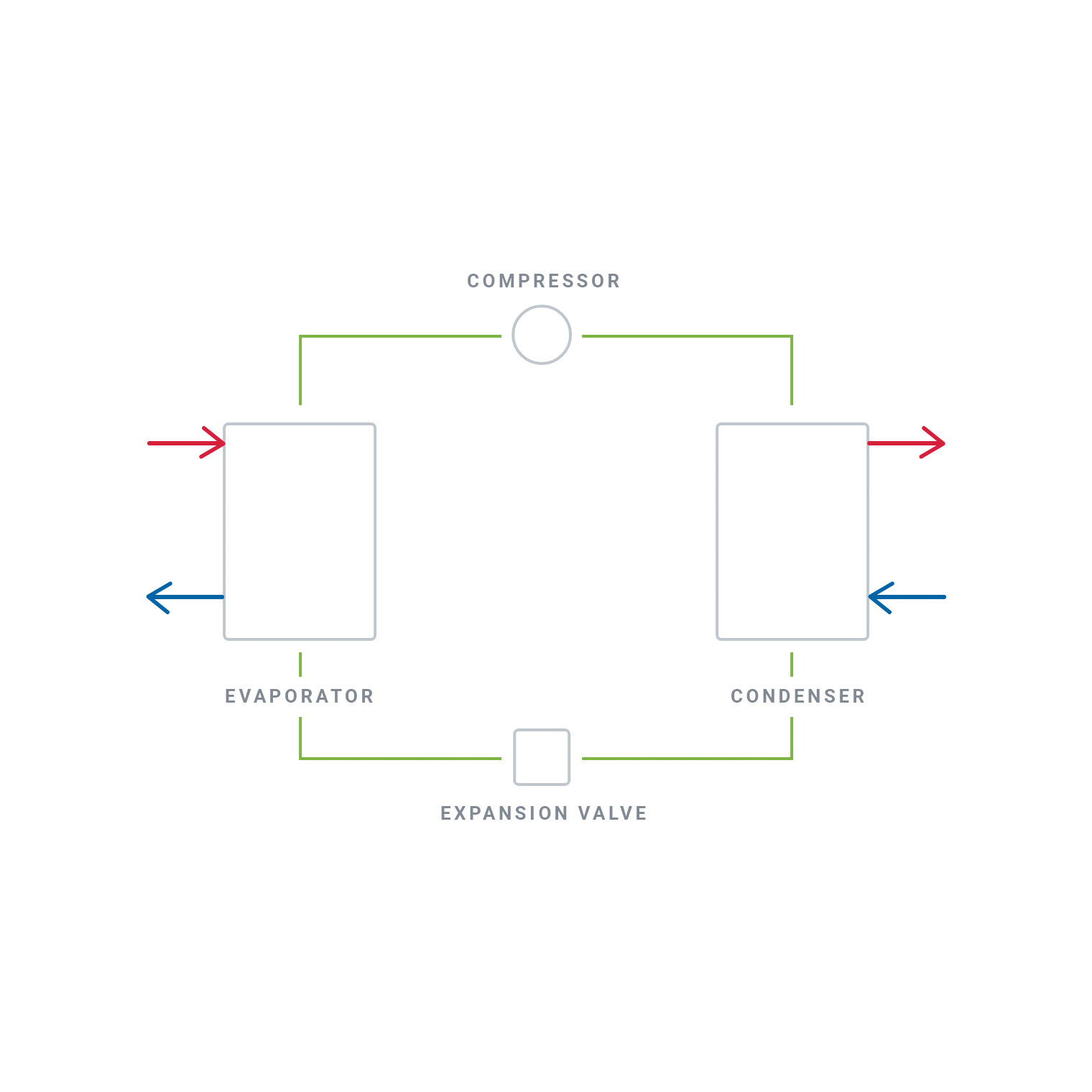High-temperature heat pumps for industry

Knowledge
Milestones of energy efficiency
Cost reduction through energy savings and competitive advantage through sustainability: these are two clear benefits that high-temperature industrial heat pumps provide to the process industry. They are an innovative solution for many industries when it comes to energy efficiency, cost savings and CO2 reduction. However, their potential remains untapped in many cases, because users are often uncertain about their potential applications.
Everything you need to know about high-temperature industrial heat pumps
In this blog article, we would like to provide you with everything you need to know about high-temperature industrial heat pumps and show you why they are so important for the future of industry. High-temperature industrial heat pumps ensure energy efficiency, cost savings and CO2 reduction and therefore enable a company to be more competitive - through profitability, but also through a better carbon footprint. In the next few years, no company will be able to ignore the issue of sustainability.
What can high-temperature industrial heat pumps do?
Unlike conventional industrial heat pumps, high-temperature heat pumps can generate process heat of up to 200 degrees Celsius by efficiently utilizing waste heat from industrial processes and converting it into the heat required in the form of steam or water. This means that the process heat at between 100 and 200 degrees Celsius that is required in many industries can be generated using the same energy-efficient technology as is used in a residential heat pump. This significantly lowers energy consumption in industry while reducing CO2 emissions This not only makes environmental but also business sense: companies are no longer subject to fluctuating energy procurement prices, can reduce their energy costs and increase their competitiveness.
High-temperature industrial heat pumps also play an important role in relation to the energy transition and climate protection. By reducing CO2 emissions, they help companies do business sustainably and therefore to achieve climate targets as well - an aspect that stakeholders are increasingly focusing on. In combination with climate-neutral green electricity, process heat can even be produced CO2-neutrally.
- Non-dependence on fossil fuels and fluctuating energy prices
- Reduction in energy consumption
- Help companies to do business sustainably
- Future viability given rising CO2 taxes
How high-temperature industrial heat pumps work
When "conventional" process heat is generated using fossil fuels, any residual heat is lost or even must be recooled using additional energy input. This is because low-temperature waste heat from production processes below 100 degrees Celsius cannot usually be put to other uses and is often discharged. This is neither efficient nor environmentally compatible. This is where a heat pump has massive potential: it uses waste heat energy as a heat source, converts it into the required process heat at high temperatures with the aid of a small quantity of electrical energy, and makes it available to industrial production processes.
How a heat pump works
The most common heat pumps are so-called compression heat pumps. This is a tried-and-tested technology that has been used in heating systems or, conversely, in refrigerators for decades. A liquid refrigerant extracts energy from the heat source (i.e., the exhaust air or, in the refrigerator, the food) and heats up as a result. Due to its low boiling point, the refrigerant evaporates and is then compressed to a higher pressure in a compressor, where it heats up substantially. A heat exchanger transfers the resulting high-temperature heat to the application system (steam or hot water), the heat sink. In the process, the refrigerant reliquefies and cools down even more. The liquid refrigerant, which is warm and under high pressure, is then expanded again to low pressure and low temperature. As this is a continuous cycle, the refrigerant can then absorb heat again. The refrigerants used are environmentally compatible media, such as propane or modern synthetic refrigerants with low GWP (Global Warming Potential). Refrigerant selection factors include thermal suitability, environmental compatibility, safety, price, and efficiency.

High-temperature industrial heat pump applications
To date, industrial heat pumps have been limited to temperatures up to about 100 degrees Celsius and are therefore unusable in many industrial processes. SPH GmbH has now developed an appealing solution, which incorporates innovative compressor technology and modular heat pump design, combined with special refrigerants, for a wide range of application scenarios. The applications are diverse: from food production (for example, sterilization and pasteurization) to distillation in the chemical or pharmaceutical industries to drying processes in paper manufacturing - wherever process heat is required, high-temperature industrial heat pumps can ensure greater efficiency and lower energy consumption. With the aid of innovative reciprocating compressor technology, they can now generate temperatures of up to 200 degrees Celsius, making them attractive to companies that require high temperatures for their processes.
- Wide range of applications in the food, chemical, pharmaceutical, or paper industries
- High temperatures achieved with the aid of innovative reciprocating compressor technology
- Even when high temperatures of up to 200 degrees Celsius are required
Advantages of high-temperature industrial heat pumps
High-temperature industrial heat pumps offer numerous advantages over heating systems that run on fossil fuels. One of the biggest advantages is their high efficiency: compared to conventional heating systems, a heat pump consumes up to 70 percent less energy. It can also be used flexibly for various applications that require process heat. In principle, it can be used wherever process heat up to a maximum of 200 degrees Celsius is required.
Another advantage is its environmental friendliness: the high-temperature industrial heat pump uses waste heat from proprietary industrial processes, thus reducing CO2 emissions. The only energy source a heat pump needs is a small quantity of electricity for its drive mechanism and some auxiliary equipment. This means that if a company purchases electricity from renewable sources, it can even reduce the CO2 emissions of its manufacturing plant to zero! This not only means non-dependence on gas as a resource, but also enables future savings, given rising carbon taxes, which are expected to double by 2026.
Applications in various industries
High-temperature industrial heat pumps are already being used successfully in various industries. Specific applications can vary depending on the requirements and processes in individual industries. We present some typical applications for high-temperature industrial heat pumps here. They are all characterized by a high heat requirement during individual process stages combined with a high level of waste heat.
Food processing industry:
- Heating and pasteurization of foods such as milk, juices, and sauces
- Drying and dehydration of foods, such as fruit, vegetables, cereals, and meat
- Cooking, baking, and other thermal processes involved in food production
Chemical manufacturing industry:
- Chemical reactions in processes such as polymerization, distillation, and catalytic reactions
- Drying and vaporization to remove moisture from chemical solutions, suspensions, and slurries
Paper industry:
- Drying processes along the entire production chain.
Prerequisites and parameters
In the past, the range of applications for industrial heat pumps was limited. They could only generate output temperatures of less than 100 degrees Celsius, while the bulk of process heat demand requires temperatures between 100 and 200 degrees Celsius. . Thanks to a specially developed high-temperature reciprocating compressor combined with the appropriate process technology, a heat pump such as the ThermBoosterTM can generate sufficiently high output temperatures of up to 200 degrees Celsius. Its multistage, modular design enables it to handle large temperature increases and raise output temperatures to the required levels. Moreover, this innovative technology is not only suitable for new manufacturing plants, but can also be retrofitted in existing plants. Read more about the ThermboosterTM in our Datasheet.
Heat pump technology, also featuring the larger capacities used in commerce and industry, is playing an increasingly important climate protection role. The fact that both users and policymakers are becoming increasingly aware of the relevance of this topic is demonstrated by VDI Guideline 4646 "Application of Large-Scale Heat Pumps", which is scheduled for the beginning of 2024. It will define the planning process for the integration of heat pumps in production plants, among other things, and develop a methodology for recording parameters and selecting the appropriate heat pump system.
High-temperature industrial heat pump costs
Compared to conventional heating systems, the investment costs for industrial heat pumps are higher. However, there are opportunities to apply for government funding, for example under the BAFA/KfW "Energy and Resource Efficiency in Industry" funding program.
The payback period depends on various factors, such as the type of heat pump, its application, and trends in energy source costs and CO2 emissions, and can therefore not be estimated across the board. In principle, however, the following applies: the more the costs for energy and CO2 emissions increase, the faster the initial investment is amortized. If designed appropriately, the additional operating costs for a heat pump are lower than for conventional heating systems, because it has a long service life and requires little maintenance.
- Investment costs higher than in conventional plants
- Payback period depends on various factors
- Operating costs lower than for conventional plants
- The higher the energy costs, the faster the amortization
- Retrofitting also feasible in existing plants
Brief conclusion
High-temperature industrial heat pumps are an increasingly important component of sustainable, efficient, and resource-saving industrial production. They exhibit their strengths in all sectors with high energy requirements, such as the chemical, paper, and food industries. Industrial companies can use this technology to significantly reduce their energy costs and eliminate their dependency on fluctuating fossil fuel prices. They also reduce CO2 emissions, aid climate protection, and enable viable industrial production in the future.
Checklist for the use of a high-temperature heat pump
- Is a suitable heat source available in the form of waste heat?
- What processes require high-temperature heat and how high is demand?
- What temperature is needed here and what is the required temperature increase?
- Is the power connection adequately dimensioned?
- Is there spatial proximity between heat source and heat sink?
- Do waste heat and heating/cooling demand occur simultaneously?
- Can subsidies be used?